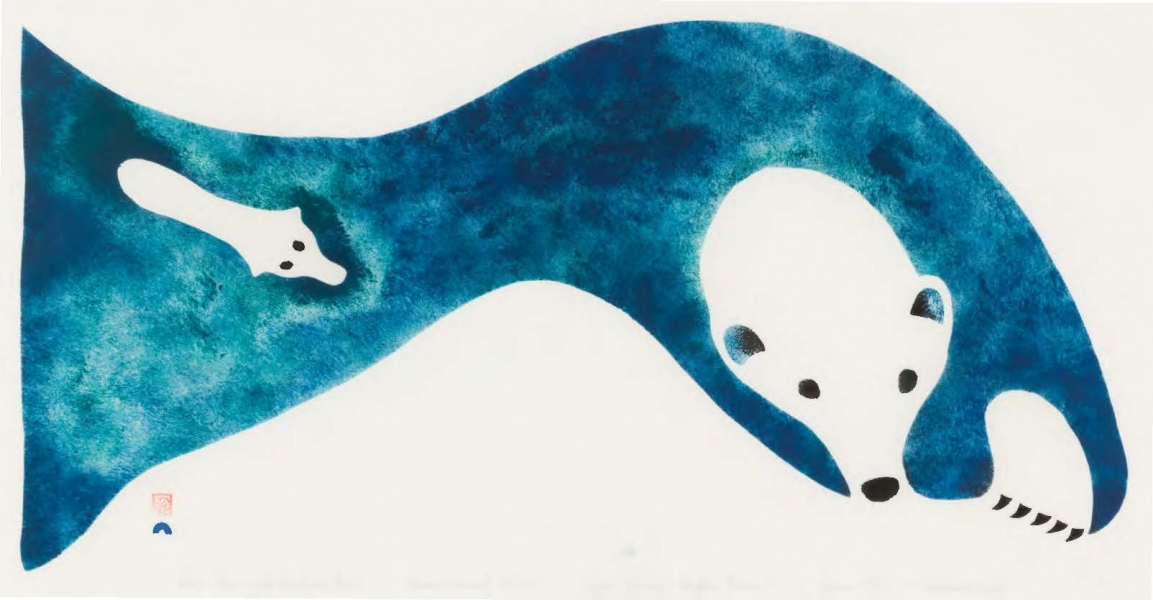 Tillirnanngittuq, pronounced "tid-ee-nang-ee-took," means 'unexpected' in the Inuktitut language. Mame Jackson, curator for this exhibition explains: “Tillirnanngittuq refers to the astonishing outpouring of Inuit art since the 1950s—a truly amazing story! Neither the Inuit artists nor those who worked with them in the early years could have foreseen the worldwide acclaim Inuit art would achieve."
Tillirnanngittuq, pronounced "tid-ee-nang-ee-took," means 'unexpected' in the Inuktitut language. Mame Jackson, curator for this exhibition explains: “Tillirnanngittuq refers to the astonishing outpouring of Inuit art since the 1950s—a truly amazing story! Neither the Inuit artists nor those who worked with them in the early years could have foreseen the worldwide acclaim Inuit art would achieve."
For more than 65 years, the Power family has been instrumental in this story and in building awareness and appreciation for Inuit art in the United States.
The Power Family Program for Inuit Art: Tillirnanngittuq exhibition showcases 58 works of art from the collection of Philip and Kathy Power. Most of these works are from the 1950s and 60s—the earliest years in the development of carvings and prints by the Inuit of the Canadian Arctic. The entire Power Collection of Inuit Art, gifted to UMMA in 2018, includes more than 200 sculptures and prints.
Visitors will discover innovative stonecut and stencil prints, and exquisite stone, bone, and ivory sculptures of arctic animals based on the artists’ life experience as traditional hunters, attentive in their observation and understanding of the animals in their environment. Slightly abstracted, this art possesses great character and vitality, elegance of line and form. The artists illustrate not only reality from nature such as how polar animals move, but also inventive design choices as they multiply, overlap, and interweave natural forms.
Among the renowned Inuit artists featured in this historic survey are Kenojuak Ashevak, Lucy Qinnuayuak, Niviaksiak, Osuitok Ipeelee, Kananginak Pootoogook, and Johnny Inukpuk.
This exhibition was curated by Marion (Mame) Jackson in collaboration with Canadian Inuit art specialist, Pat Feheley. Jackson (PhD, UMich,1985) is an art historian and professor emerita, Wayne State University and The University of Michigan. Pat Feheley is Director of Feheley Fine Arts in Toronto, a world-renowned gallery devoted exclusively to traditional and contemporary art from the Canadian Arctic.
Saturday, March 16, Philip Power, Mame Jackson and Patricia Feheley will participate in a panel discussion moderated by Vera Grant, UMMA Deputy Director for Curatorial Affairs and Curator of Modern and Contemporary Art (4–5:30 p.m., Helmut Stern Auditorium). Other events will also take place that day (film screening, family art studio, storytelling, and tours of Tillirnanngittuq).
The Power Family Program for Inuit Art is dedicated to fostering the study and appreciation of Inuit Art. Christina Olsen, UMMA Director, describes the Program’s importance: “Tillirnanngittuq is the first in many exhibitions, programs, and research efforts that will explore Inuit and Canadian Arctic art’s historic impact and contemporary concerns. This Program is an exciting new direction for UMMA. It positions the Museum as a national leader in the curation, exhibition, research, and appreciation of Inuit art.” Pat Feheley explains how the Power family collection can contribute to the field of research: “The Powers’ collection, because of the records that were kept, is well documented. It can therefore provide a base for study of other collections of similar work.”
The Power Family Program for Inuit Art was established in 2018 by Philip and Kathy Power through the promised gift of their extraordinary Inuit art collection and a $2 million endowment. For more information, please contact: UMMA-Power-Program@umich.edu.
The University of Michigan Museum of Art seeks to transform individual and civic life by promoting the discovery, contemplation, and enjoyment of the art of our world. We do that by making dynamic exhibitions and programs about our encyclopedic collection, and by inviting artists, scholars, students and others to collaborate with us. The Museum and its events are always free, and all are welcome.
